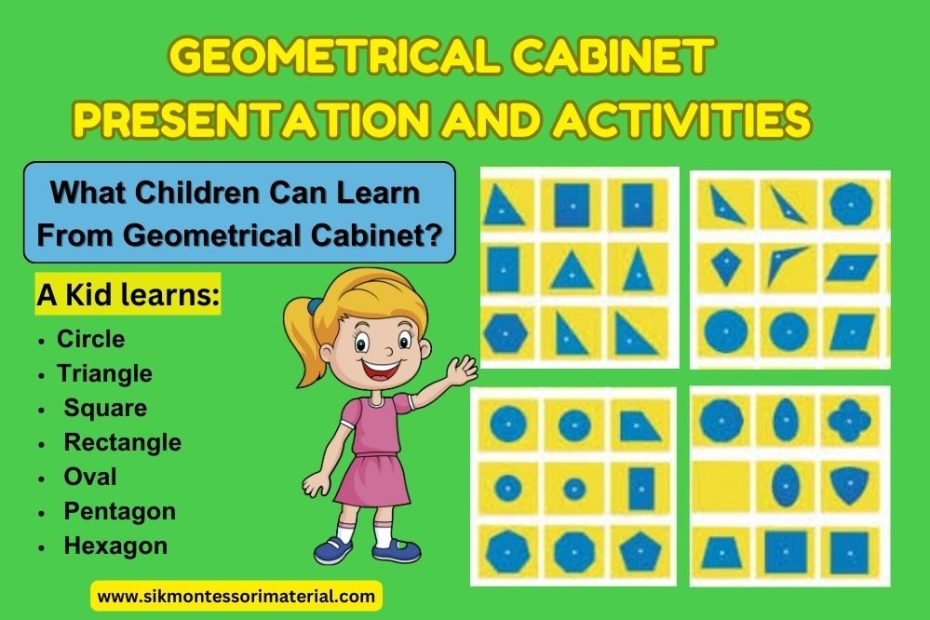What is the Montessori Geometrical Cabinet?
The Montessori Geometrical Cabinet is a wooden cabinet with six drawers. Each drawer contains different geometric shapes such as circles, triangles, and rectangles. Children use this tool to learn about geometry, shapes, and their properties.
Purpose of Introducing Geometrical Cabinet
The main purpose of the Geometrical Cabinet is to teach children about geometric shapes. It helps them recognize, name, and understand the properties of different shapes. It also enhances their visual and tactile perception.
What Age Can You Introduce the Montessori Geometrical Cabinet?
You can introduce the Geometrical Cabinet to children around 3 to 4 years old. It is suitable for preschoolers and helps them explore and learn about shapes.
Learn Vocabulary
Children expand their vocabulary by naming and describing shapes. They use words like circle, triangle, square, and rectangle. As they handle the shapes, they also learn terms like side, angle, and vertex. This helps them build a strong foundation for language and mathematical concepts. Some vocabulary words are given below.
Vocabulary Associated with Geometrical Cabinet Activity
- Shape
- Circle
- Triangle
- Square
- Rectangle
- Oval
- Pentagon
- Hexagon
- Side
- Angle
- Edge
- Vertex
- Curve
- Flat
- Straight
- Geometric
- Fit
- Match
- Drawer
- Insert
- Remove
How to Perform Class Activity with Montessori Geometrical Cabinet
- Gather the children and show them the Geometrical Cabinet.
- Open each drawer and name the shapes.
- Demonstrate how to remove and insert shapes back into the drawer.
- Let each child take a turn handling the shapes.
- Encourage them to name the shapes and describe their features.
Developmental Benefits of the Geometrical Cabinet
The Montessori Geometrical Cabinet provides numerous benefits for a child’s development. It engages multiple senses and helps children develop important skills. By exploring the cabinet, children learn more than just geometric shapes. They improve their sensory perception, motor abilities, and cognitive skills. These are some of the benefits written below.
Sensory Development
Children use their senses to explore the shapes in the Geometrical Cabinet. They touch and feel the edges, corners, and surfaces of each shape. This tactile experience enhances their sensory perception and helps them understand the properties of different shapes.
Fine Motor Skills
The Geometrical Cabinet helps children improve their fine motor skills. They use their hands to grasp, pick up, and place the shapes into the correct slots. This activity enhances their hand-eye coordination and dexterity.
Shape Discrimination
Children learn to discriminate between different shapes by using the Geometrical Cabinet. They compare and contrast the shapes to find the right match. This skill helps them notice differences and similarities between geometric forms.
Grasp Size and Shape Concepts
Children grasp the concepts of size and shape by handling various geometric forms. They learn what makes a square different from a triangle or a circle. This understanding helps them recognize and categorize shapes in their environment.
Focus and Concentration
Using the Geometrical Cabinet requires children to focus and concentrate. They pay attention to details to fit the shapes into the correct slots. This activity improves their attention span and encourages them to stay engaged with the task.
Ensure Safe Usage of Geometrical Cabinet with Children
Make sure the Geometrical Cabinet has smooth edges and is made of nontoxic materials. Always supervise young children during play to prevent any accidents.
Control of Error
The design of the Geometrical Cabinet includes built-in control of error. If a shape does not fit, the child knows it is incorrect and tries again. This encourages independent problem-solving and helps children learn from their mistakes.
Points of Interest
The variety of shapes and their properties attract children’s attention. The challenge of fitting shapes into the correct slots keeps them engaged. The bright colors and smooth surfaces add to the appeal.
Final Thoughts
The Montessori Geometrical Cabinet is an excellent tool for early childhood education. It combines learning with play, helping children develop essential skills in a fun way. Moreover, it fosters a love for learning and exploration, setting a solid foundation for future academic success. As children engage with the Geometrical Cabinet, they not only learn about shapes and geometry but also develop critical thinking and problem-solving abilities that will benefit them throughout their lives.
Frequently Asked Questions
Question. Can children work with Geometrical Cabinet individually?
Answer. Yes, children can use the Geometrical Cabinet on their own. It helps them develop independence and self-confidence.
Question. Are Geometrical Cabinets only used for sensorial development?
Answer. No, the Geometrical Cabinet also teaches problem-solving, vocabulary, and basic geometry concepts.
Question. What is demonstrating order of Geometrical Cabinet?
Answer. Demonstrating order refers to the process of showing children how to use the cabinet step by step. It ensures they understand how to handle and match shapes correctly.
Question. Why do we call it Geometrical Cabinet?
Answer. We call it the Geometrical Cabinet because it is a cabinet that stores various geometric shapes.
Question. What happens if a child struggles with Geometrical Cabinet?
Answer. If a child struggles, offer gentle guidance and encouragement. Show them how to try different shapes until they find the right match.
Question. Can Geometrical Cabinet be used at home or only in a classroom setting?
Answer. The Geometrical Cabinet can be used both at home and in a classroom. It is a versatile tool for learning in various environments.
Question. Are there extensions to the Geometrical Cabinet activity?
Answer. Yes, you can extend the activity by introducing more complex shapes or combining it with other learning materials, such as shape tracing or drawing activities.

